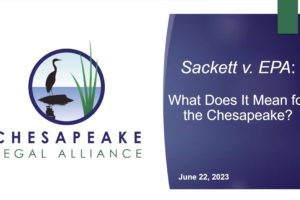The Clean Water Act at 50
By Evan Isaacson
With eyes currently focused on Washington’s debate over potentially transformative legislation to remake America’s safety net and infrastructure, it is worth remembering a similar moment in American history 50 years ago this month. In October 1971, the U.S. Senate introduced the Federal Water Pollution Control Act Amendments of 1972, now known and celebrated as the Clean Water Act.
As this iconic American law turns a half century old, it is important to take a look back at the creation of the Clean Water Act. In this post, and a subsequent post that takes a look at what has become of the Clean Water Act today, we explore its history, its present use, and its future. Chesapeake Legal Alliance would not exist, and we could not do the job we are doing today, if not for the Clean Water Act. So for the next year, we will continue to celebrate what some have called “one of the greatest government achievements of the second half of the 20th century.” We hope you will join.
In February 1961, during his first address to Congress, President Kennedy declared that the nation’s water pollution problem had reached “alarming proportions” and announced several executive actions along with his call for sweeping legislative reforms. Several weeks later, the President gave his famous speech committing the United States to sending a man to the moon by the end of the decade. On July 20, 1969, the United States landed a man on the moon. That same month 100,000 barrels of oil blackened dozens of miles of beaches surrounding Santa Barbara, painting in stark relief the difference between Kennedy’s call to win the space race and his call to protect water quality.
The 1960s saw not only oil-slicked beaches, but rivers on fire, and fish kills so massive that they clogged the intake pipes for municipal drinking water plants. It is not as if Kennedy’s urging went unheeded. New legislation was enacted in 1961, 1965, 1966, and again in 1970. The Supreme Court issued one of the first landmark environmental cases in 1966, helping to define the scope of future water pollution regulation. Even the election of President Nixon in 1968 resulted in the later creation of the new Environmental Protection Agency and several surprisingly bold executive orders. All three branches of the federal government were working to modernize and reform the existing legal structures to reduce water pollution and restore water quality that had previously been mostly the individual responsibility of the 50 states.
Despite these efforts, the state of the nation’s waters remained in “deplorable” condition by the end of the decade and the key ingredient to fixing this problem remained missing. What turned the tide? A simple, broad brush answer would look something like this: outraged by environmental catastrophes and images of pollution in newspapers and on television and inspired by the first Earth Day celebration, the American people demanded Congress pass a new law, and listening, Congress invented an entirely new law.
The real story, of course, is much more complicated and nuanced. In fact, most of the key components of the Clean Water Act existed in one form or fashion in the previous iterations of the Federal Water Pollution Control Act and its predecessors, including laws as far back as the Rivers and Harbors Act of 1899. What transformed the Clean Water Act into the transformative law it became were several key features, including the outright prohibition on discharging pollutants into waterways without a permit, or in violation of a permit, new enforcement authority for the federal government and for the public, and – not to be underestimated – bold and ambitious declarations of Congressional intent.
Intent language is often a forgotten or ignored aspect of statutes. The Clean Water Act, however, was imbued with the values of its chief architect, Senator Edmund Muskie of Maine. Senator Muskie had long been a champion of water pollution control legislation, constantly introducing new amendments to the Federal Water Pollution Control Act during the 1960s and early 1970s to make the previous law more enforceable and less reliant on the states, which Congress understood had always been captured by local special interests and incapable of ensuring the attainment of their own state water quality standards.
Muskie delivered a powerful address at the first Earth Day celebration, declaring war on poverty, hunger, and pollution, and pronouncing that “the only society that has a chance” is one that “will not tolerate slums for some and decent houses for others, rats for some and playgrounds for others, clean air for some and filth for others.” Muskie saw the right to a healthy environment as important enough to deserve federal protection for all Americans. And, crucially, he understood that “the power of the people is in the courts,” a nod to the need for citizen suit authority in environmental statutes.
While many in Congress felt the overwhelming desire of their constituents to take action to protect the air, water, and public health, only a few members like Senator Muskie knew that a revolutionary approach to statutory and regulatory environmental protections would be needed to finally ensure “achievement” of water quality goals, avoiding yet more of the “unfulfilled promises” that resulted from previous legislation.
Under Muskie’s leadership, his Senate Subcommittee crafted much of the language of what became the modern Clean Water Act between March and July of 1971. During hearings, industry lobbyists did what they could to beat back proposals to establish federal permits with nationwide technology-based and water quality-based standards, to include civil penalties, and to give the American people the ability to enforce the law. These criticisms, which just a few years before would have carried the day and sunk the bill by overwhelming margins, fell on deaf ears. The subcommittee and full committee voted unanimously to pass a Clean Water Act with teeth.
Then, fifty years ago this month, the full Senate heard the landmark bill. Despite decades of concerns about federalism, fiscal and economic concerns, and many other red herring arguments, the bill passed 86-0 on November 2, 1971. It would take another several months of wrangling with the House and a veto override to enact the Clean Water Act. But the spirit of today’s Clean Water Act, that started with public pressure and Senator Muskie’s vision, survived the political process.
The new provisions introduced by the Senate 50 years ago defined what the Clean Water Act would become and how and why it remains just as powerful and potent to this day. If not for an enforceable law that allows the public to sue to enforce its provisions and compel the government to do its job, we would not be on our way to a clean and restored Chesapeake Bay today. If not for these laws, organizations like ours would not exist. You and I would have to plead with each of our individual states to protect what we care about – to please stop illegal pollution, to please do something to resurrect the Chesapeake Bay, to please protect our health, to please do something to bring back striped bass, blue crabs, and oysters. Thanks to the Clean Water Act, we do not have to beg. And we do not have to ask politely. Thanks to the Clean Water Act, we can exercise our statutory rights to stop pollution and clean up cherished resources.
Please join us in celebrating the Clean Water Act’s 50th birthday over the course of the next year. This is the first of several posts written by CLA staff and board members, several of whom were present at the creation of the Clean Water Act. Our next post will look at what has happened over the last half century to lead us to where we are today. We look forward to celebrating this incredible achievement in our work towards clean water with you.




